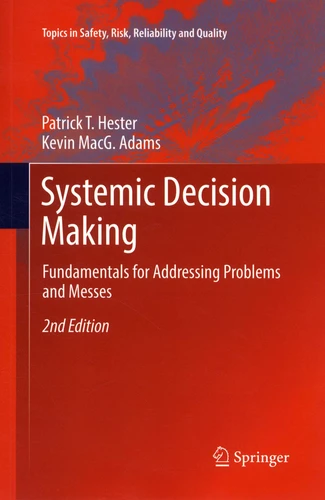Systemic Decision Making. Fundamentals for Addressing Problems and Messes
2nd edition
Par : , Formats :
- Paiement en ligne :
- Livraison à domicile ou en point Mondial Relay indisponible
- Retrait Click and Collect en magasin gratuit
- Réservation en ligne avec paiement en magasin :
- Indisponible pour réserver et payer en magasin
- Nombre de pages432
- PrésentationBroché
- FormatGrand Format
- Poids0.835 kg
- Dimensions15,6 cm × 23,5 cm × 2,0 cm
- ISBN978-3-319-85450-2
- EAN9783319854502
- Date de parution01/01/2017
- CollectionTopics in Safety, Risk, Reliab
- ÉditeurSpringer Nature
Résumé
This expanded second edition of the 2014 textbook features dedicated sections on action and observation, so that the reader can combine the use of the developed theoretical basis with practical guidelines for deployment. It also includes a focus on selection and use of a dedicated modeling paradigm - fuzzy cognitive mapping - to facilitate use of the proposed multi-methodology. The end goal of the text is a holistic, interdisciplinary approach to structuring and assessing complex problems, including a dedicated discussion of thinking, acting, and observing complex problems.
The multi-methodology developed is scientifically grounded in systems theory and its accompanying principles, while the process emphasizes the nonlinear nature of all complex problem-solving endeavors. The authors' clear and consistent chapter structure facilitates the book's use in the classroom.
The multi-methodology developed is scientifically grounded in systems theory and its accompanying principles, while the process emphasizes the nonlinear nature of all complex problem-solving endeavors. The authors' clear and consistent chapter structure facilitates the book's use in the classroom.
This expanded second edition of the 2014 textbook features dedicated sections on action and observation, so that the reader can combine the use of the developed theoretical basis with practical guidelines for deployment. It also includes a focus on selection and use of a dedicated modeling paradigm - fuzzy cognitive mapping - to facilitate use of the proposed multi-methodology. The end goal of the text is a holistic, interdisciplinary approach to structuring and assessing complex problems, including a dedicated discussion of thinking, acting, and observing complex problems.
The multi-methodology developed is scientifically grounded in systems theory and its accompanying principles, while the process emphasizes the nonlinear nature of all complex problem-solving endeavors. The authors' clear and consistent chapter structure facilitates the book's use in the classroom.
The multi-methodology developed is scientifically grounded in systems theory and its accompanying principles, while the process emphasizes the nonlinear nature of all complex problem-solving endeavors. The authors' clear and consistent chapter structure facilitates the book's use in the classroom.

